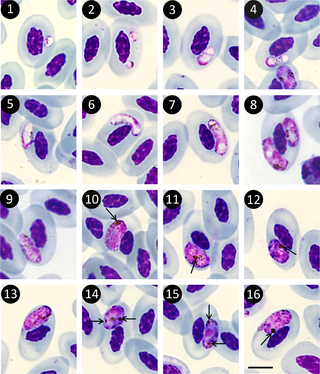
Plasmodium is a genus of unicellular eukaryotes that are obligate parasites of vertebrates and insects. The life cycles of Plasmodium species involve development in a blood-feeding insect host which then injects parasites into a vertebrate host during a blood meal. Parasites grow within a vertebrate body tissue before entering the bloodstream to infect red blood cells. The ensuing destruction of host red blood cells can result in malaria. During this infection, some parasites are picked up by a blood-feeding insect, continuing the life cycle.

The Plasmodiidae are a family of apicomplexan parasites, including the type genus Plasmodium, which is responsible for malaria. This family was erected in 1903 by Mesnil and is one of the four families in the order Haemospororida.
Plasmodium lepidoptiformis is a parasite of the genus Plasmodium.
Plasmodium minasense is a parasite of the genus Plasmodium subgenus Carinamoeba.
Plasmodium circularis is a parasite of the genus Plasmodium subgenus Sauramoeba.
Plasmodium australis is a parasite of the genus Plasmodium.
Plasmodium volans is a parasite of the genus Plasmodium subgenus Carinamoeba.
Plasmodium kentropyxi is a parasite of the genus Plasmodium subgenus Sauramoeba.
Carinamoeba is a subgenus of the genus Plasmodium - all of which are parasitic unicellular eukaryotes.
Plasmodium guyannense is a parasite of the genus Plasmodium subgenus Sauramoeba. As in all Plasmodium species, P. guyannense has both vertebrate and insect hosts. The vertebrate hosts for this parasite are reptiles.
Plasmodium lionatum is a species of apicomplexan parasite in the family Plasmodiidae. Like all Plasmodium species P. lionatum has both vertebrate and insect hosts. The vertebrate hosts for this parasite are lizards.
Plasmodium vacuolatum is a parasite of the genus Plasmodium.
Plasmodium vastator is a species of apicomplexan parasite in the family Plasmodiidae. The vertebrate hosts for this parasite are reptiles.
Plasmodium neusticuri is a parasite of the genus Plasmodium.

The Haemosporida are an order of intraerythrocytic parasitic alveolates.
Fallisia siamense is a parasite in the family Garniidae.
Plasmodium carmelinoi is a parasite of the genus Plasmodium.
Plasmodium intabazwe is a parasite of the genus Plasmodium subgenus Lacertamoeba.
Plasmodium caucasica is a parasite of the genus Plasmodium subgenus Sauramoeba. As in all Plasmodium species, P. caucasica has both vertebrate and insect hosts. The vertebrate hosts for this parasite are reptiles.


